Are bifold doors the best way to bring the great outdoors into your shed?
What are bifold shed doors used for?
Bifold doors are used when the space outside a shed or outbuilding is limited, you want to create a relatively large opening width and don't have the wall space for a sliding door. This might be because you are short on physical space or it could be that the ground slopes upward and there isn't room for a full width door to swing outwards.
Bifold shed doors are also a good option when you want to create a large opening in the front of your shed. This was the case in this summer house. By cleverly designing the hinge locations an opening of almost 2/3rd the width of the building was created and still the doors neatly folded up against the outside of the building walls, not compromising the internal space.
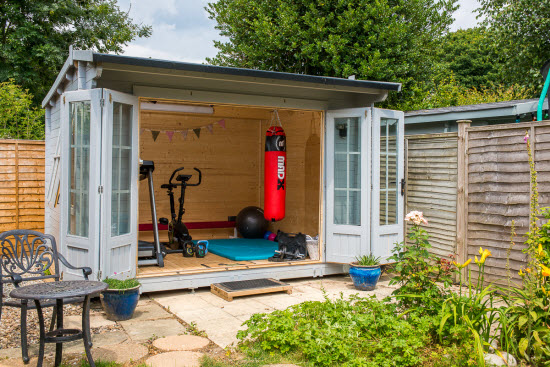 A good example of how a bifold doors can create a large opening in a shed. Two sets of bifold shed doors enable 2/3rds of the shed wall
to be opened to the fresh air.
A good example of how a bifold doors can create a large opening in a shed. Two sets of bifold shed doors enable 2/3rds of the shed wall
to be opened to the fresh air.
Bifold doors can also be used as an alternative to shed double doors. One of the leaves can be kept locked in place most of the time with tower bolts. With only one leaf used for regular access, both doors can be opened when an especially large or bulky item needs to be moved.
How do bifold shed doors work?
Bifold shed doors are made up of two door leafs which are hinged to the door frame and also hinged to each other.
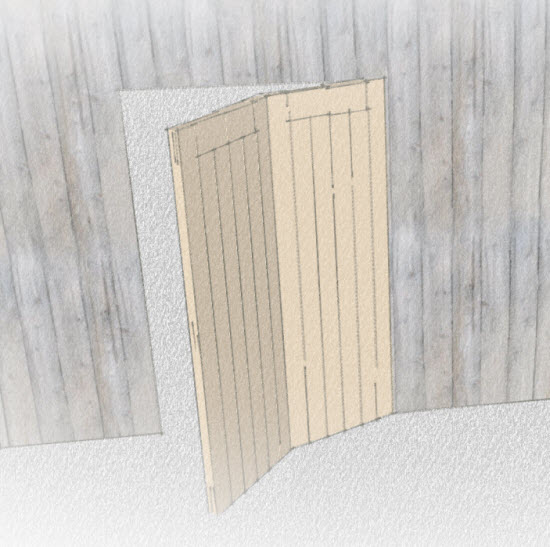 Simple arrangement of bifold shed door
Simple arrangement of bifold shed door
The exact arrangement of the bifold shed door hinges depends on how you want the door to work.
In the summerhouse example above the door leaf adjacent to the hinge folds outwards and the outer leaf folds further again so that both doors can be hooked back to the wall of the summer house.
The exact articulation of the door depends on how you want the door to work and the shed door hinges that you have at your disposal.
The hinges supporting the inner leaf must be strong as they are supporting two door leafs. The hinges might be cross garnet hinges or long T hinges.
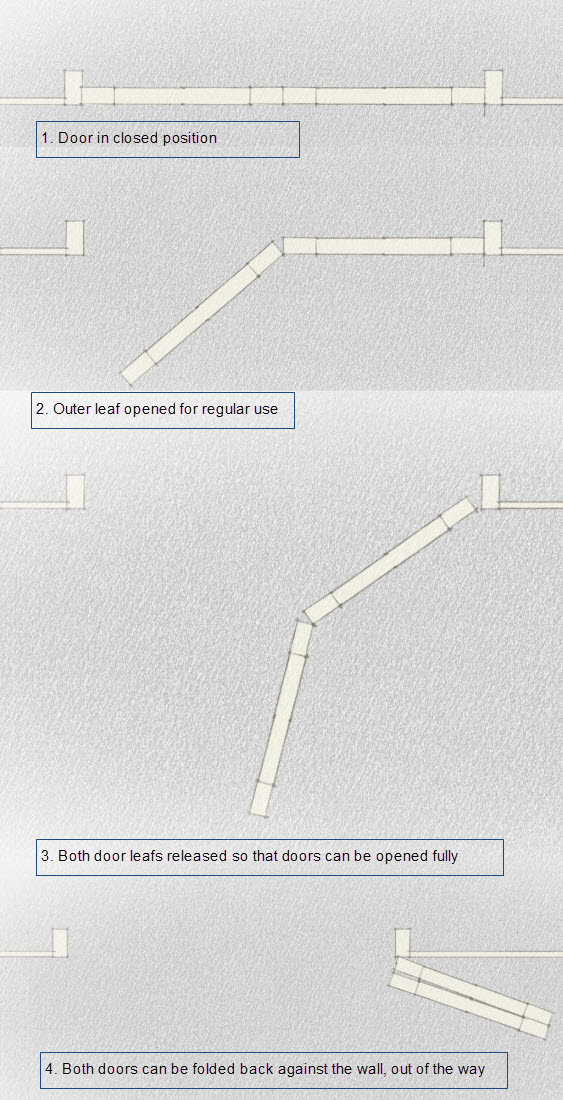 Articulation arrangement for bifold shed doors
Articulation arrangement for bifold shed doors
The inner door leaf also has two tower bolts on the inside near the outer edge of the door. These bolts secure the door in place for the majority of the time when the outer door is being used for more regular access.
The outer door leaf is hinged on to the inner door leaf. In my preference this is using standard butt hinges to the door frame (I would recommend a framed door in this situation) . But strap hinges can be used but they would be on the outside of the door so you would have to be happy that they added to the appearance of the door.
The outer leaf can be secured with a mortice or rim lock into the door frame.
Bifold doors can be used singly as in one of the examples below or in pairs to create an extra wide opening.
Why not connect even more doors together to create a trifold of quadfold door?
This is done but the difficulties of the accumulation of movement through several sets of hinges mean that additional support is required to the doors.
This is provided by either supporting the doors in a channel at the head of the door or at the base of the door. Doors of this type can be quite heavy and are known as sliding folding doors.
Sliding folding doors quickly become heavy and expensive, so are mainly used on swanky garden offices or extensions.
What hardware to use on bifold shed doors?
There are four pieces of hardware that you will need to get your bifold shed doors functioning like a dream. These are:
Hinges - Two types of hinges are used. Standard butt hinges are used for connecting one door to the next and 'broad butt' or Parliament hinges are used for connecting the pair of doors to the frame. The reason for this type of hinge at the door frame is that the hinge pin is located at least half the door width away from the door. This mean that the doors can fold back on themselves when opened.
Lock - A rim lock or mortice lock can be used. Dependent on your door design and security requirements.
Tower bolt - These are used to secure the inner door leaf to the frame at the top and floor at the base.
Cabin hooks - Cabin hooks are used to hold the folded door in position. Bifold doors are quite large and unwieldy if caught by the wind.
What are the problems with bifold doors?
Bifold doors are a specific solution to a problem in themselves, but they can have difficulties. The main one is that if they are not sufficiently strong they will sag, over time and start to bind on the frame or the floor.
The main way to avoid or overcome this is to make sure that you use hardware that is sufficiently strong, particularly the hinges. And also that the door itself is rigid and won't sag. The best way to have a rigid door is to install a framed ledged and braced door. These are made of timber and are a cut above your average ledged and braced door.
The frame that is built-in to the door helps to stop the door from warping out of a flat plane. It also provides a very solid anchorage point for the door hinges. Whilst the braces minimise the possibility of any sagging taking place.
Lets have a closer look at the construction of a framed ledged and braced doors.
How to build bifold doors for a shed
Ledged and braced doors are the standard type of shed door. They are formed from a series of boards connected by horizontal ledgers and then braced by diagonal boards, both fixed on the rear of the door.
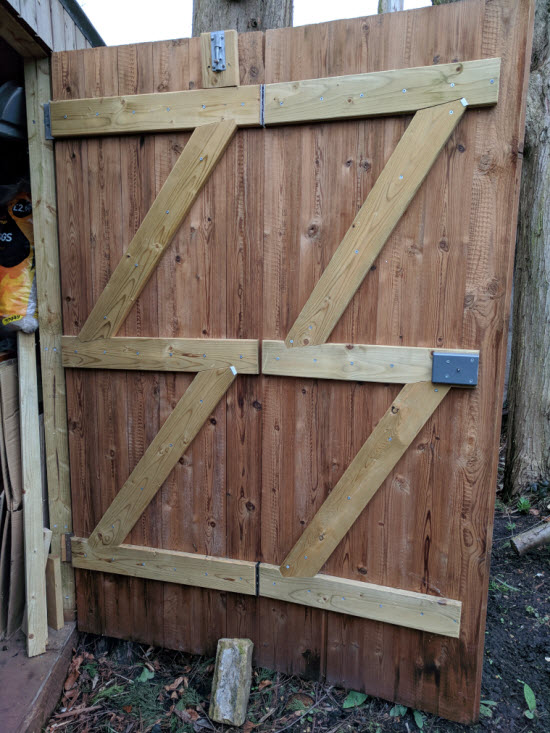 This ledged and braced bifold door suffered issues with sagging. It is recommended that you don't use a ledged and braced door for bifold doors.
This ledged and braced bifold door suffered issues with sagging. It is recommended that you don't use a ledged and braced door for bifold doors.
The door type you should use for bifold shed doors is a framed, ledged and braced door. This type of door is stronger and lighter than ledged and braced doors. The solid timber around the full perimeter of the door gives you very good fixing points for the bifold hinges.
As the door isn't relying on door face timber for much strength it can be thinner, whilst still retaining security. This means that the door is lighter and so has less tendency to sag.
Well made framed doors are also more 'torsionally stiff', this means that they have less tendency to warp. Which once again isn't ideal for a relatively complex arrangement such as bifold doors.
The bifold door below has a solid timber frame around the perimeter. It uses three parliament hinges to connect it to the frame and then three standard butt hinges to connect one door to the other.
When building bifold doors you will need to be very clear on your hinge dimensions and pivot points.
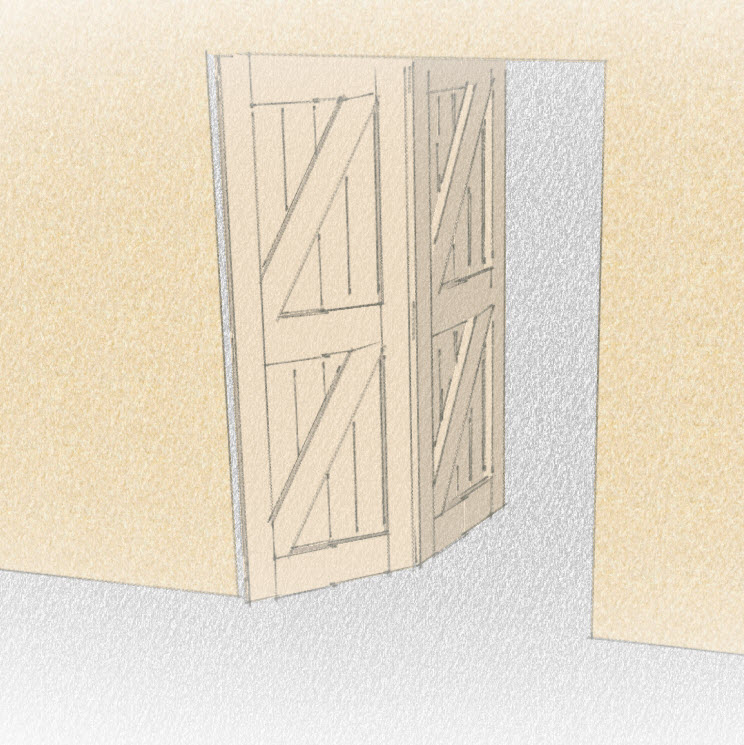 This door has a solid frame around the perimeter as well as being braced
This door has a solid frame around the perimeter as well as being braced
As you can see from the shed door plan below the perimeter of the door has a frame made of 4x2 stiles with a 6x2 top rail and 4x1 1/2 mid and bottom rails. The top rail is connected to the stiles with a haunched tenon whilst a bare faced tenon is used for the mid and bottom rails. The cross braces are installed so that the top end is housed directly into the top and mid rail whilst the bottom end is housed into the stile and rail with a stump tenon joint.
 General arrangement of framed, ledged and braced door
General arrangement of framed, ledged and braced door
This arrangement of framing doors allows the use of 1/2" thick facing board without compromising on door strength, which has the benefit of saving on weight.
Summary of the benefits of bifold shed doors
Bifold doors are an excellent way of creating a large opening (and being able to secure it) in your shed.
Bifold doors don't require expensive or complicated hardware. But do require some detailed planning to get the dimensions and articulation just right.
I recommend that you use framed, ledged and braced doors. This will help you to minimise possible issues with sagging or warping of the doors.
Related posts:

Keep in touch with our monthly newsletter
Shed Building Monthly




